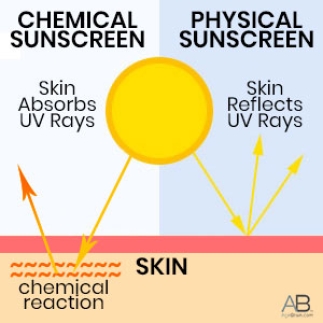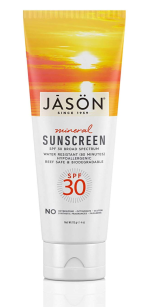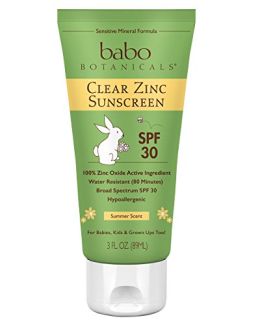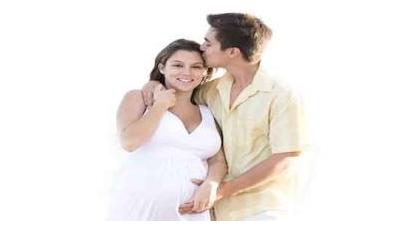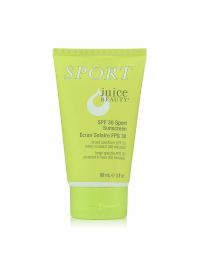There are many varieties of sunscreen on the market, but these can be grouped into two categories: physical and chemical. Physical sunscreens form a protective barrier on your skin to block UV rays, while chemical sunscreens absorb UV rays so they do not damage your skin. Some health concerns have been raised regarding the compounds in chemical sunscreens, so physical sunscreens may be a healthier choice for multiple reasons.

How Physical Sunscreens Work
As the name suggests, physical sunscreens work by creating a physical barrier which blocks UV rays from the sun from reaching your skin. There are two minerals which are used in physical sunscreens, zinc oxide and titanium dioxide, which reflect UV light off of the layer they form. Older types of these mineral sunscreens tended to appear chalky; however, thanks to improved technologies which can make smaller mineral particles, you can now find ones that become transparent when you apply them.1
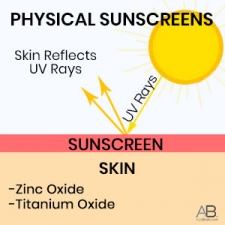

How Chemical Sunscreens Work
Chemical sunscreens contain compounds which absorb the photons in UV radiation so they cannot pass into your skin. These are organic molecules with chemical structures that absorb specific types of energies, such as that from UV rays. Instead of forming a layer on top of your skin, chemical ingredients are absorbed into your skin. Currently, there are 14 different chemicals that have been approved by the FDA for use in sunscreens. The most commonly used of these is oxybenzone, in around two thirds of sunscreens on the market. Many types of sunscreen contain more than one active ingredient.1
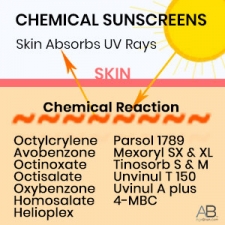

Chemical Sunscreens May Cause Hormonal Dysregulation
The chemical structures of the compounds used in chemical sunscreens are similar to other organic molecules produced by our bodies. Several chemicals are similar enough to natural hormones that they can bind to hormone receptors in your cells and interfere with hormone signaling. Oxybenzone in particular is an estrogen mimetic, and can cause reproductive changes in women and lower testosterone in men.2,3 Others, including octinoxate and homosalate, can alter the regulation of estrogen, progesterone, or thyroid hormones.3 You should avoid these chemicals in particular if you are pregnant or nursing, and should not put them on infants or children who are still developing.
Our Recommendation: Try a chemical free sunscreen with excellent protection and without any harmful ingredients like Jason Mineral Sunscreen.

Physical Sunscreens are Healthier for You and the Environment
On top of the hormonal effects discussed above, certain chemicals in sunscreens are known to cause skin reactions. Oxybenzone, octinoxate, octisalate, octocrylene, and avobenzone can cause skin allergies, so you may want to avoid these if you have sensitive skin.4 What’s more, newer studies have indicated that chemicals in sunscreen have toxic effects on corals. Oxybenzone in particular has been linked to major bleaching in coral reefs.5
On the other hand, physical sunscreens do not typically cause any skin reactions. Nanoparticles of zinc oxide and titanium dioxide are small enough to be absorbed by corals and cause toxicity as well5; however, “non-nano” minerals, with particle sizes of 100 nanometers or larger, have been determined to be safe for corals.6

Zinc Oxide Provides the Best UV Protection
One thing to consider is that there is more than one type of UV radiation. UVA rays can penetrate deep into your skin and cause oxidative damage that leads to aging effects like wrinkles and age spots. UVB rays cause more damage to the surface of your skin, resulting in sunburn effects. Both types of UV can damage the DNA in your skin cells, which can lead to the development of cancers like melanoma. For full protection, you should use a broad-spectrum sunscreen that protects against both UVA and UVB radiation.
Most FDA-approved sunblock ingredients provide adequate protection against UVB. However, only two compounds provide protection against UVA: avobenzone and zinc oxide. As discussed earlier, avobenzone has potentially toxic properties, plus it does not provide much protection against UVB. Zinc oxide, on the other hand, is safe to use and provides protection against both UVA and UVB.7
[1] Hanson K. 2017. “Column: How the chemistry of sunscreen is protecting your skin this Memorial Day.” PBS News Hour. https://www.pbs.org/newshour/science/column-chemistry-sunscreen-protecting-skin-memorial-day
[2] Ghazipura M, McGowan R, Arslan A, Hossain T. 2017. “Exposure to benzophenone-3 and reproductive toxicity: A systematic review of human and animal studies.” Reprod Toxicol.Oct; 73:175-183. https://www.ncbi.nlm.nih.gov/pubmed/28844799
[3] Krause M, Klit A, Blomberg Jensen M, Søeborg T, Frederiksen H, Schlumpf M, Lichtensteiger W, Skakkebaek NE, Drzewiecki KT. 2012. “Sunscreens: are they beneficial for health? An overview of endocrine disrupting properties of UV-filters.” International Journal of Andrology. May; 35(3). https://onlinelibrary.wiley.com/doi/full/10.1111/j.1365-2605.2012.01280.x
[4] 2017. “The Trouble With Ingredients in Sunscreens.” Environmental Wellness Group.https://www.ewg.org/sunscreen/report/the-trouble-with-sunscreen-chemicals/#.Wt1JM5ch3IU
[5] Nelson M. “Is Your Sunscreen Stressing Out Coral Reefs?” Prized Writing. 2013-2014: 120-127. UC Regents, Davis Campus. http://prizedwriting.ucdavis.edu/sites/prizedwriting.ucdavis.edu/files/users/snielson/120isyoursunscreenstressing.pdf
[6] Glusac, Elaine. “Most Sunscreens Can Harm Coral Reefs. What Should Travelers Do?” The New York Times,February 19, 2018. https://www.nytimes.com/2018/02/19/travel/most-sunscreens-can-harm-coral-reefs-what-should-travelers-do.html
[7] Environmental Protection Agency. “Sunscreen: The Burning Facts.” EPA 430-F-06-013, September 2016. https://www.epa.gov/sites/production/files/documents/sunscreen.pdf
-
Sunscreen vs Sunblock
By Dr. AnnaDecember 20, 2021 -
Pregnancy-Safe Sunscreens
By Dr. AnnaDecember 20, 2021 -
Reef Safe Sunscreens
By Dr. KarenDecember 21, 2021 -
Zinc Oxide Sunscreen
By Dr. KarenDecember 21, 2021 -
Best Baby Sunscreen
By Dr. AnnaDecember 17, 2021
Search the blog
Article Categories
- All Articles (95)
- Rating Charts (1)
- Beauty & Skincare (17)
- FAQ (0)
- Hair Care (9)
- Health & Wellness (12)
- Anti-Aging (4)
- Kid's Health (0)
- Makeup (2)
- Men's Health (2)
- Oral Care (3)
- Sunscreen (7)
- Skin Tools & Treatments (10)
- Supplements (26)
- Videos (0)

